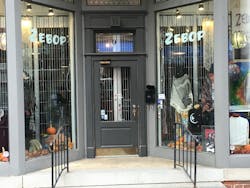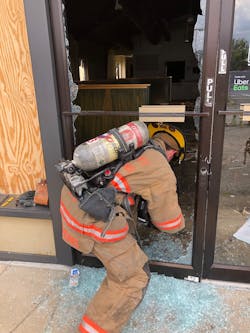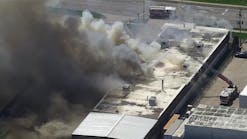Residential forcible entry is an art. It must be practiced and fine-tuned continually. In fact, once you master the art, you’ll realize that all of the doors that you forced previously were a matter of luck.
Commercial forcible entry isn’t any different. Again, it’s an art that must be practiced. However, it can be challenging for members to practice commercial forcible entry, because there aren’t many commercial forcible entry props on the market. Nonetheless, you must find a way to know what to do and how to operate when the time arises for you to make entry into a commercial structure.
Being fast is good, but being effective and efficient and making sure that your tactics are worthwhile to the overall achievement of fire suppression on scene is more important. When it comes to being effective in commercial forcible entry on the fireground, there are three important skills:
- The ability to defeat the lock by going around the door
- The skill to go through the lock
- The ability to resist the urge to blow the storefront glass in the heat of the moment
The right tools
To accomplish the first two points, you must have the right tools. Aside from the conventional irons, what else should you bring? Remember, if you have numerous tool options, you can pick and choose what you need in the moment.
It can be difficult for some people to determine what forcible entry tools other than the irons might be needed at the site of the forcible entry and what tools can stay on the rig. Consider the “force bag.” This small tool bag holds all of the “other tools” that you don’t use regularly but can help in a pinch. Our department’s force bag includes a Vice-Grip, chain, metal chocks, lock picks, shove knives, a K-Tool, key tools and a modified Channellock, among other tools. Bringing this bag with the irons to the commercial storefront gives the entry person options for executing how that individual will want to go about making entry.
Of course, conditions that are presented dictate what tactics to use. Regardless, the mission always should be to resist the urge to blow the storefront glass (which is covered below).
There are a couple of options for you if you want to go around the door to the lock. Around-the-door-to-the-lock tactics are based completely on the tools that you have with you. One constant: You always must have the Halligan.
The simplest forcible entry tactic for commercial doors is using the adze of the Halligan. The objective of using the adze is to get the lock to “pop” from the door frame. It’s very simple: Insert the Halligan just above or below the door’s pivoting lock, in the small gap that’s between the frame and the door. (For some doors, there might not be a gap that’s big enough to fit the Halligan. If this situation presents, then you must make the gap by rotating the bar to create that space.) Overall, the objective is to get the adz of the Halligan on the backside of the door, rolling the bar off of the frame. This should get the door’s locking mechanism to pop out from the frame.
When you encounter a door that has multiple locks, you can repeat this tactic. You just must remember to progress capture every gap that’s made by using chocks.
Be cautious when you rotate the bar in the gap of the frame. If you see the glass flexing, there is a possibility that it can break in the door, depending on how well it’s secured in there.
Another option for going around the door to the lock is cutting the lock. This is done by cutting the pivoting lock with a K-12 that’s fitted with a metal blade while it’s in the upright “locked” position in the door frame. This tactic can be accomplished rather quickly.
Through-the-lock tactics generally aren’t as fast as the around-the-door tactics, because going through the lock requires the use of multiple tools. However, this tactic is good for those nonemergent calls where you must get in with little damage and speed isn’t a major factor. With through-the-lock, you have options that involve the use of the K-tool and the key tools, the modified Channellock or other types of lock-pulling tools. Regardless of your choice of tools, you first must pull the lock cylinder from the door so as to gain access inside of the frame, to manipulate the actual lock.
Manipulating the lock rolling pin often can give members a difficult time after the lock is pulled. Be sure to look inside to find the pin to ensure that you are manipulating the pin from the five o’clock position to the seven o’clock position or vice versa. Depending on how the lock is installed in the door, you can find it positioned in either of those fashions.
Regardless of your choice of tactics, you must resist the urge to blow out the storefront glass because “it’s easy.” When you blow out the glass, you make things a little more complicated for everyone on the fireground. Consider these challenges:
- When the glass is blown out, you no longer can control the flow path of fresh air that’s entering the structure. This can be very detrimental to the survivability of occupants who might be trapped in the rear of the structure.
- Storefront glass crumbles into a million pieces. Glass from a storefront door on the ground makes opening the door very challenging. To get the door to open in such an instance requires someone to rake all of the glass that’s on the ground in front of the door. This can consume personnel who some departments might not have.
- As the first hoseline gets in place going through the inside of the glass frame of the door, once the line becomes charged, the door can’t be opened for the rest of the incident, which means everyone, and all subsequent lines, must enter through that storefront door frame.
- Nobody on the fireground ever removes the door’s cross push handle right away, so everyone who operates on scene, in full PPE and SCBA, must duck under the handle to enter the doorway, thus making the space more difficult to navigate.
Second nature
Ultimately, your training will dictate your actions when you arrive on the fireground or at incident scene. The more prepared that you are, the less amount of time that you will spend applying poor tactics, because making entry will be second nature to you.
Find the time with your crews to go out in your response area to look at the different commercial forcible entry challenges that you have. You’ll see that there can be many opinions regarding tactics for making entry among your crew members, which is a good thing.

Robert "RJ" James
Robert “RJ” James is a 22-year veteran of the fire service. He started as a volunteer firefighter with the Cromwell, CT, Volunteer Fire Department. After that, James joined the Rockville Volunteer Fire Department in Montgomery County, MD. He currently is a career lieutenant in Special Operations Command assigned to the 3rd Battalion with the Frederick County, MD, Fire Department. James served as a lead instructor for many fire department trainings and works as an instructor, including with Capitol Fire Training. He has received numerous citations and awards. James has written articles for numerous magazines and has taught on national fire service platforms.









